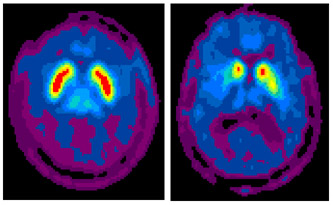
|
Raman ChirakalAssociate Professor,Department of Radiology B.Sc. (Kerala), M.Sc. (Brock), Ph.D. (McMaster)
Radiopharmaceuticals for Positron Emission Tomography |
My main pursuits are research and development of radiopharmaceuticals
for Positron Emission Tomography (PET). PET uses specific molecules
labelled with a positron emitting (neutron deficient) isotopes
such as 18F, 11C, 13N and 15O.
It is an imaging technique that allows the circulatory and metabolic
behaviour of small, well-defined volumes of any body tissue to
be monitored and measured without trauma in living patients.
I am part of a multi-disciplinary health professional group comprising
chemists, physicists, medical technologists, nurses and physicians.
Our laboratory is equipped with a 11 MeV proton cyclotron and
hot cells with remote handling equipment to process large quantities
of radioactive materials. My research interests lie in the area
of production of shortlived radiopharmaceuticals for the
investigation of cerebral metabolism and disorders of human brain,
such as schizophrenia and Parkinson's disease, using PET. Particular
emphasis is placed on the development of efficient methods for
the routine production of 18F-labelled nucleophilic
and electrophilic fluorinating agents and the identification and
characterization of radionuclidic impurities produced in 18F
(t1/2 = 110 min) and 13N (t1/2
= 10 min) targets and their rapid chemical separation.
Fluorine-18 is also used as a tracer to probe inorganic and organic
reaction mechanisms with emphasis towards the production of 18Flabelled
imaging agents. Techniques employed for identification and characterization
of radiolabelled compounds include radio-HPLC, TLC, autoradiography,
mass spectrometry, 1H, 13C, 19F
NMR and g-ray spectroscopy.

Selected Publications
- Raman Chirakal, Neil Vasdev, Gary J. Schrobilgen, Shigeko
Amano and Claude Nahmias. "Synthesis of Fluorine-18 Labelled 2-,
5- and 6-Fluoro-L-DOPA and Their in vivo Behaviour in the
Human Brain," Radiochimica Acta, (2000) (in Press).
- Lindi M. Wahl, Jia Jun Chen, Margo Thompson, Raman Chirakal
and Claude Nahmias. "The time course of metabolites in human plasma
after [18F]6-fluoro-L-m-tyrosine administration."
Eur. J. Nucl. Med., (1999), 26, 1407.
- Raman Chirakal, Neil Vasdev, Gary J. Schrobilgen and Claude
Nahmias. "Radiochemical and NMR spectroscopic investigation of the
solvent effect on the electrophilic elemental fluorination of
L-DOPA: synthesis of [18F]5-fluoro-L-DOPA." J. Fluorine
Chem., (1999), 99, 87.
- R. Chirakal, G. Coates, G. Firnau, G.J. Schrobilgen and C.
Nahmias. "Direct Fluorination of Dopamine: 18F-Labelled
6-Fluorodopamine for Imaging Cardiac Sympathetic Innervation in
Humans Using PET." Nucl. Med. Biol., (1996), 23, 41.
- R. Chirakal, M. Adams, G.J. Schrobilgen, G. Firnau and E.S.
Garnett. "Electrophilic 18F from a Siemens 11 MeV Proton-only
Cyclotron." Nucl. Med. Biol., (1995), 22, 11.
- R. Chirakal, B. McCarry, M. Lonergan, G. Firnau and E.S. Garnett.
"BaseMediated Decomposition of a Mannose Triflate During
the Synthesis of 2-18FDG," Appl. Radiat. Isot., (1995)
46, 149.
Contact Information
|
Mailing Address: Dr. Raman Chirakal Department of Radiology McMaster University Hamilton, Ont., Canada L8N 3Z5 |
Telephone: Voice (905) 525-2100, ext. 76893 FAX (905) 522-2509 |
|
Office: HSC-1P10B Laboratory: HSC-1P10B |
E-mail: chiraklr@fhs.mcmaster.ca
|
Chemistry Faculty
Department of Chemistry
Department of Radiology
McMaster Radiochemical Laboratory for PET Radiopharmaceuticals
16feb2000; rc
